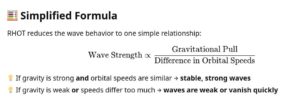🌌 Resonant Harmonic Orbit Theory (RHOT): A Simple Explanation for Waves in Rings and Galaxies
By : Khawar Nehal
Date : 1 August 2025
📜 Introduction
Look at Saturn’s rings 🪐 or a spiral galaxy 🌠. Both have beautiful wave-like patterns—spiral arms or rippling rings. Why do these patterns form? Why do they look like harmonic vibrations in music 🎵?
The Resonant Harmonic Orbit Theory (RHOT) offers a simple and unified explanation. Instead of complex equations, RHOT uses an intuitive idea:
👉 Gravity acts like a spring, and
👉 Orbital motion acts like a driver,
👉 Together, they create harmonic waves in cosmic disks—just like standing waves on a guitar string.
🔑 Core Idea
RHOT treats any rotating disk of particles—like Saturn’s rings or a galaxy—as a giant resonant system.
- Gravity = Pulls particles back to their stable orbits (restoring force ⚖️).
- Orbital motion = Creates constant energy differences (driving force 🔄).
- Perturbations (moons, clumps, or collisions) = Excite waves 🎶.
When these effects combine, waves form at specific harmonic ratios, just like musical notes.
🎵 Why Harmonic?
A guitar string vibrates at specific frequencies—1st harmonic, 2nd harmonic, 3rd harmonic…
Similarly, particles in a disk prefer certain orbital ratios where waves remain stable.
These ratios show up as:
✅ Spiral arms in galaxies (2, 3, or 4 arms most common)
✅ Ripple-like density waves in Saturn’s rings
📐 How RHOT Works
1️⃣ Gravitational Harmony Principle
Every particle tries to follow a stable orbit. But if a group of particles is nudged, gravity pulls them back like a spring.
2️⃣ Resonant Driving Principle
When the same place is nudged repeatedly (by a moon 🛰️ or a clump of mass 🌌), particles start to oscillate in sync—a resonance.
3️⃣ Self-Sustaining Wave Principle
Once formed, the wave keeps moving, even as particles pass through it—just like a stadium wave 🙌.
🪐 Saturn’s Rings Example
- Saturn’s moons pull on the ring particles at regular intervals.
- Where the moon’s orbit matches a simple ratio with the ring particles (like 2:1 or 3:2), spiral density waves appear.
- These waves look like ripples in a pond—but on a cosmic scale!
🌠 Galactic Spiral Arms Example
- A galaxy is a rotating disk of stars and gas.
- Mass clumps or past collisions create disturbances.
- Because gravity acts like a spring, the disturbance travels as a wave, forming spiral arms that stay in place while stars pass through.

🔮 Predictions of RHOT
✅ Galaxies will prefer spiral arms in simple ratios (2, 3, or 4 arms).
✅ Saturn’s rings will have the strongest waves at moon resonance points (already observed by Cassini).
✅ Protoplanetary disks (where planets form) will also show wave-like structures influencing planet growth.
📊 How RHOT Differs From Other Theories
| Theory | Concept | Complexity |
|---|---|---|
| Newtonian/GR Models | Exact gravitational motion | High |
| Lin-Shu Density Wave Theory | Fluid dynamic wave analysis | Very High |
| RHOT (New) | Harmonic oscillator + resonance 🎵 | Simple ✅ |
🎯 Why RHOT is Powerful
✅ Unifies two phenomena: Saturn’s rings and galactic spiral arms.
✅ Simple and intuitive: Works like music harmonics.
✅ Predictive: Explains why certain patterns are more stable.
🌌 A Cosmic Music of the Spheres
Kepler once imagined the “Music of the Spheres”—planets moving like musical notes 🎶.
RHOT revives this idea in modern form: gravity and motion together create cosmic harmonies.
From the smallest ice particles in Saturn’s rings to billions of stars in galaxies—the universe may really be playing music. 🎻🌠
Leave a Reply